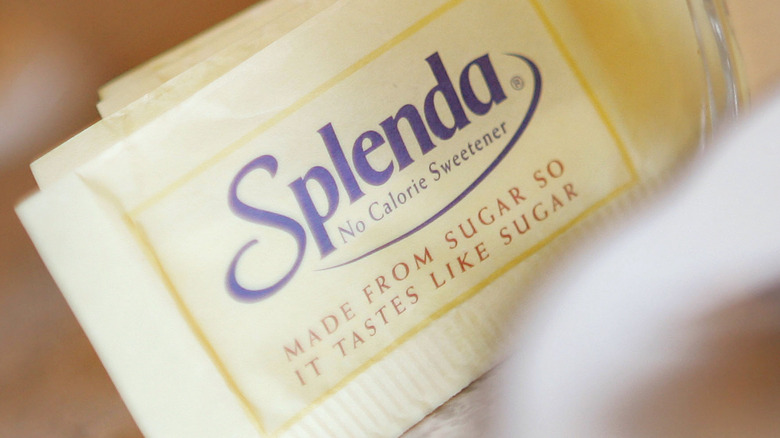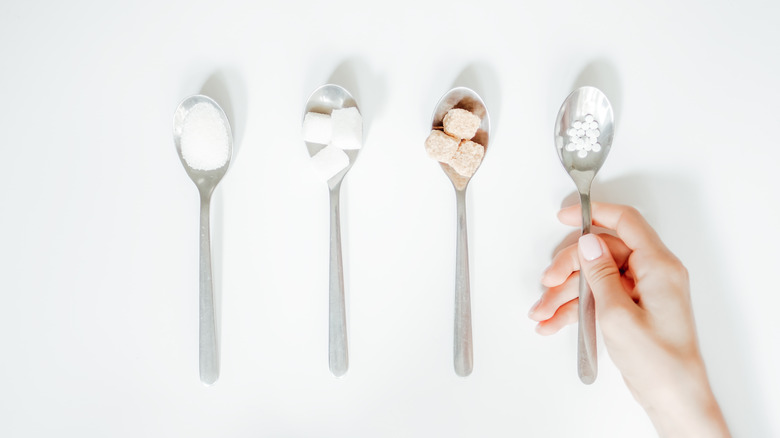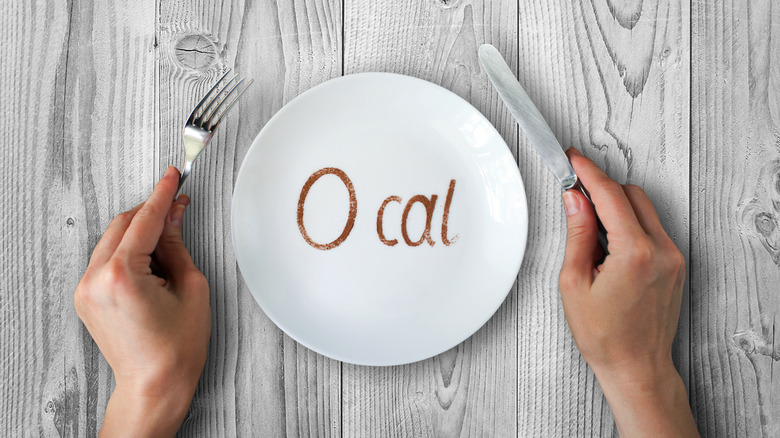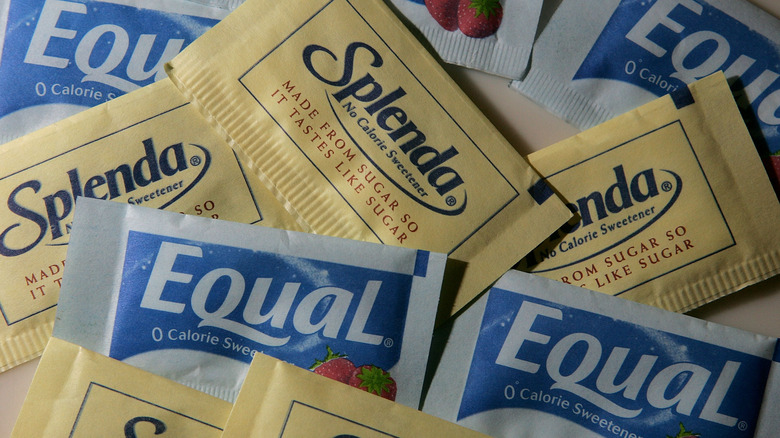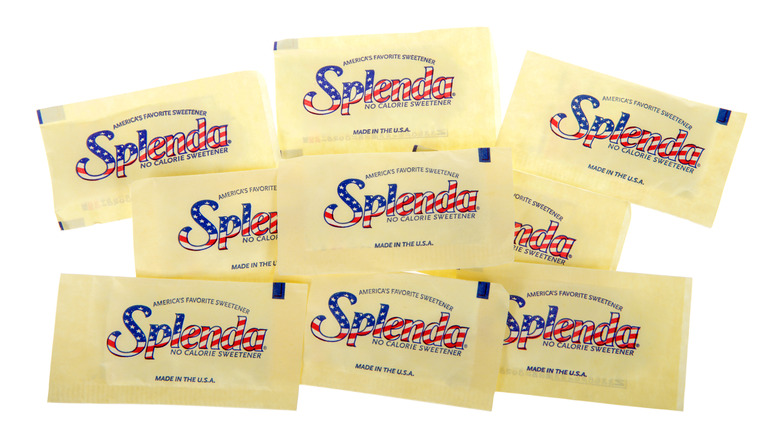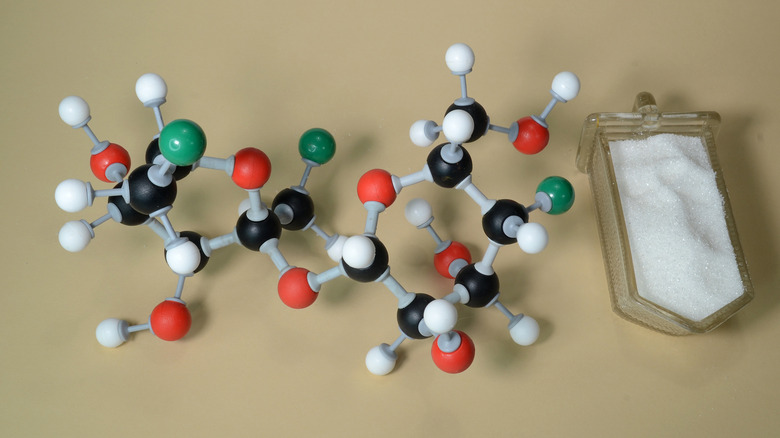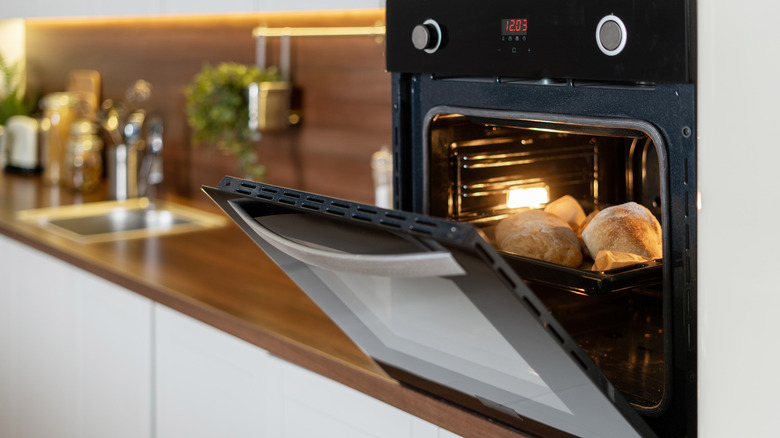The Untold Truth Of Splenda
Splenda packets in restaurants are about as ubiquitous as silverware. Since their initial release in the U.K. in 1992, Splenda has sold over 100 billion of those little yellow parcels, making them one of the most popular artificial sweeteners on the market. They are also one of the sweetest — sucralose, Splenda's star ingredient, is around 600 times as sweet as sugar. Sucralose's overly sweet taste is thanks to its chemical composition, which is remarkably similar to a traditional sugar molecule.
Artificial sweeteners like Splenda are appealing to many groups, including the diet-conscious (who are seeking to cut sugar or calories from their diet), diabetics (whose bodies have trouble processing traditional sugar), and dentists (who love them in chewing gum and candies since they are less likely to cause cavities or gum issues). But although Splenda is FDA approved, some claim it has the potential to cause a variety of negative health effects.
From its accidental creation and current market dominance to its potential to wreck your gut health and ruin your baked goods, read on to learn the truth behind this popular sugar substitute.
It was not the first artificial sweetener
While Splenda is the dominant artificial sweetener on the market, it was by no means the first. That title belongs to saccharin, which was discovered in 1878. As the story goes, a Johns Hopkins professor failed to wash his hands after a series of experiments, and, after picking up a dinner roll, found his meal to be exceptionally sweet. The professor left his lab after the discovery, taking several students with him, and began producing saccharin for commercial sale. It quickly became popular as a preservative, a sugar alternative for diabetics, and as a general medicine. Although it was almost banned in both 1907 and 1977 for fears of health effects, public support allowed saccharin to stay on shelves.
In the time between saccharin's invention and the arrival of Splenda in 1976, scientists discovered several other artificial sweeteners, starting with cyclamate (via Saveur). According to Saveur, the sweetener was invented in 1937, and was the star ingredient of Sweet N' Low and many diet sodas before its 1970 FDA ban. Aspartame was next, invented in 1965. However, the controversy surrounding cyclamate delayed its introduction to the market until 1981.
Splenda's discovery was somewhat of an accident
Like saccharin before it, the sucralose that makes up Splenda was discovered in a lab accident. The mistake was a result of a lab tech mishearing instructions — his supervisors told him to test the compound, but he heard "taste." This mistake turned out to be a profitable one, as sucralose's extreme sweetness may have otherwise gone undetected (tasting chemicals, after all, isn't necessarily a common lab practice). The discovery prompted sugar company Tate & Lyle to begin using the compound in artificial sweeteners. Twenty-three years after the sweet mistake, Splenda was introduced to American markets, quickly becoming the top-selling artificial sweetener (via Healthline).
According to Saveur, artificial sweeteners and tasting accidents have historically gone hand in hand: in addition to saccharin and sucralose, aspartame and cyclamate were also discovered thanks to careless or confused lab techs. It turns out serendipity really is sweet.
Splenda isn't actually calorie free
Artificial sweeteners are often marketed for their no-cal nature, but with Splenda, that might not be as true as you think. We'll be honest, at four calories per packet, the count here isn't exactly groundbreaking –- but it is deceptive, as Splenda both displays zero calories on its nutrition label, and markets itself as a "zero calorie sweetener" right on the box.
This mislabeling is actually perfectly legal. Believe it or not, an FDA loophole states that anything with fewer than five calories can legally be labeled as "'calorie-free,' 'free of calories,' 'no calories,' 'zero calories,' 'without calories,' 'trivial source of calories,' 'negligible source of calories,' or 'dietarily insignificant source of calories.'" This means that Splenda is far from the only product to make this claim. Many alternative sugars do, according to Foodbeast, even "natural" ones like monk fruit and stevia. So do spray oils and fat-free dressings, which are marketed as "healthier" despite containing this misleading product claim. Business Insider reports that diet sodas also utilize this loophole.
Splenda made a serious impact on the market
After its 1999 U.S. release, Splenda skyrocketed in popularity during the early 2000s. Although sales of the other top five alternative sweeteners fell in between March of 2004 and 2005, Splenda sales increased by 34%, and the sugar substitute industry as a whole grew by 6.7% (via Supermarket News). By early 2005, Splenda represented 51% of the sugar substitutes market. Folks in the industry attributed Splenda's success to "diabetics, dieters and possibly mothers concerned about tooth decay," even saying it "transformed" a section of the market that for nearly a decade and a half didn't see much growth.
Today, Splenda's figures continue their upward trend. Revenue in Tate & Lyle's "Food and Beverage Solutions segment" grew by 19% during six months in 2021, according to Food Business News. However, the brand's success is no longer limited to just sucralose: Their new products had a lot to do with this growth, especially the stevia line, whose revenue grew by 165% in the first half of the year.
Splenda was sued by a sugar association
Not everyone appreciated Splenda's sudden success. The brand quickly made enemies of The Sugar Association, an interest group for the American sugar industry, who sued Splenda's marketing company for false advertising in 2004. The Sugar Association called into question Splenda's tagline, "made from sugar, so it tastes like sugar," which featured prominently on its product packaging.
Technically, the tagline is true: sucralose is made by replacing hydrogen and oxygen groups on traditional sugar molecules with chlorine atoms. While The Sugar Association did not dispute this claim, they argued that it was misleading, confusing consumers into thinking Splenda was real sugar rather than a substitute. In addition to filing the suit, the group created www.thetruthaboutsplenda.org to educate consumers on the differences between traditional sugar and Splenda, as well as inform them of potential health effects.
The suit reached a settlement in 2008 before going to trial, although the details of the agreement remained private. Additionally, the company settled out of court with the makers of Equal in 2007, who claimed the tagline made Splenda appear better for you than other artificial options. Although this settlement was also private, it's important to note that current Splenda products only feature half the tagline, instead claiming, "Tastes like sugar!"
Splenda is more than just sucralose
Artificial sweeteners are usually differentiated based on their key ingredient (such as aspartame in Equal, or anything in those generic blue packets, saccharin in Sweet n Low or pink packets, and sucralose in Splenda or yellow packets). But Splenda contains more than just the ingredient it's known for.
Splenda is made of a blend of dextrose, maltodextrin, and Splenda trademarked sucralose, in that order. That means that Splenda is not even the top ingredient in Splenda! According to ChemEurope, Splenda packets are actually 95% dextrose, making this the ingredient to which we should be paying the most attention. The dextrose in Splenda is supposed to act as a carrier for the sucralose, allowing the packet to feel as full as its competitors. However, dextrose is much closer in nature to traditional table sugar, meaning your body reacts to it similarly and it can spike your blood pressure. The fact that Splenda's main ingredient acts so similarly to sugar in the body undercuts Splenda's marketed use as a sugar alternative.
Additionally, the Splenda brand is no longer just sucralose products. The company has incorporated more sugar alternatives into the fold, including on-trend natural sweeteners like monk fruit and stevia, in an attempt to stay relevant. They even created a tongue-in-cheek commercial for the stevia line ahead of the 2020 Golden Globes, which compared the stevia plant to marijuana and used the tagline "The sweetest thing you could grow."
You can cook with it (kind of)
Cooking and baking with artificial sweeteners can be a tricky task. For one, some are heat sensitive, and either become less sweet, change color, or change texture in the oven. Since many sugar alternatives are sweeter than sugar, it can also be difficult to figure out measurements, as they cannot be replaced cup for cup. Luckily for Splenda fans, the brand has created a line of products just for baking to help ease the process.
The baking line features many benefits not seen in other artificial sweetener brands. Splenda's original baking sweetener can be used to replace sugar cup for cup, which makes measuring less complicated. They also have a brown sugar blend to help dishes achieve richer flavors. Additionally, all five alternative sweeteners in the line come with their own set of tips to make things easier, including advice for high-altitude baking, microwave cooking, frozen desserts, yeast-activated treats, and confections.
While Splenda may be a viable artificial alternative for cooking, it doesn't really brown and the texture can be iffy. Additionally, it may create harmful compounds when exposed to heat, a process that can start at temperatures as low as 248F. However, many regulation and consumer protection entities stand by the claims that sucralose poses no health risks when heated.
Splenda might not be great for you
Unfortunately for Splenda fans, this artificial sweetener might not be as great for you as it claims to be. For one, it might wreak havoc on your gut health. A 2008 study showed that rats who ate sucralose for 12 weeks had 47-80% fewer anaerobic bacteria in their stomachs (anaerobes are essential for digestion, immune health, and potentially even mental health). Additionally, the rats' good bacteria populations were the most diminished, while bad bacteria populations seemed less harmed.
Another study found that consuming sucrose combined with a carbohydrate like maltodextrin (which, you may remember, is the second ingredient in Splenda) can lead to glucose intolerance and an increased risk of diabetes. What's more, is this change in metabolism happens very quickly — the study participants only consumed seven maltodextrin/sucrose beverages over a two-week period before seeing the consequences. The same carbohydrate-sucralose mix can also cause your body to lose its metabolic bearings, making you unable to feel satiated by sweet things. This can lead to rapid and excessive weight gain, as well as general "metabolyic dysfunction." Lastly, repeated sucralose consumption can put you at risk for high blood pressure and heart disease. To make a long story short, do your research before making Splenda your go-to sweetener.
